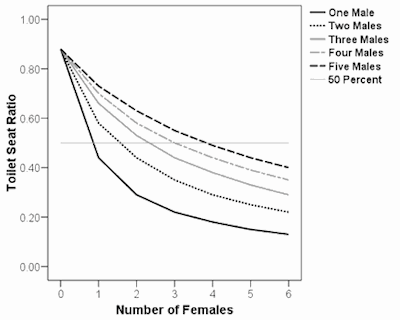UP OR DOWN? AN EFFICIENCY-BASED ARGUMENT FOR OPTIMAL TOILET SEAT PLACEMENT
As long as males and females have been living with indoor plumbing they have argued over the placement of the toilet seat. Most often, males leave the toilet seat up and females leave the toilet seat down. Males may not necessarily have a problem with the toilet seat down, but then females will suffer from wet bottom syndrome from time to time. If males leave the seat up, females may “fall” into the toilet particularly at night. A solution to this problem is to always leave the toilet seat in a particular position: the toilet seat remains down and males must lift the toilet seat to urinate, but then return it to its down position; alternatively, the toilet seat remains up and females must always place the seat down to use the toilet and return it to its upright position when done.
The trouble with this solution is: in which position should the toilet seat be placed? This decision has, no doubt, been the source of many arguments in male-female households. Previous scientific research has been undertaken on this household problem. Choi (2002) uses an optimization method to identify the efficient placement of the toilet seat. He finds that unless the costs of changing the toilet seat position are asymmetric across the parties involved, the optimal toilet seat placement follows the selfish rule: do not change the toilet seat position when you are finished using the toilet. Harter (2005) and Siddiqi (2006) both use game theoretic models to show that optimal toilet seat placement is up. However, Harter (2005) does note that in order to avoid marital conflict the toilet seat may best be in the down position.
In this paper, an efficiency-based argument is used to show which position the toilet seat should be in, depending on the composition of the household. This is done through a mathematical modeling approach that extends previous research by considering households with more than one male and more than one female. Because it takes effort to raise and lower the toilet seat, the toilet seat should be left in the position that minimizes the number of times it must be moved. It is shown that the optimal toilet seat placement depends on the ratio of males to females.
In order to determine the optimal toilet seat placement, a mathematical modeling approach is taken. In order to perform such modeling, a number of axioms must be made.
Axiom 1: Females always use the toilet with the seat in the down position.
Axiom 2: Males urinate with the toilet seat up in the up position and defecate with the toilet seat in the down position.
Axiom 3: Males and females defecate once per day and urinate 7 times per day.
Axiom 3 is clearly critical for the results, but in a sensitivity analysis the results presented below were shown to be robust. Considering these axioms, the toilet seat ratio is calculated as follows:

This ratio is bounded by zero and unity. If the TSR is greater than 0.50, the optimal toilet seat placement is up; if the TSR is less than 0.50, the optimal toilet seat placement is down; and if the TSR is equal to 0.50 the optimal placement is either up or down. The TSR is calculated for all combinations of 1 – 5 males and 0 – 6 females.
The results of the mathematical modeling are shown in Figure 1 and Table 1. Figure 1 also shows the 0.50 mark (grey line) and all TSR values greater than 0.50 in Table 1 are in bold.
Figure 1. Toilet Seat Ratio

Table 1. Toilet Seat Ratios, ad nauseam

The first point to notice in this analysis is that the claims of previous research have not been replicated here: when there is one female and one male in the household the optimal toilet seat placement is down. However, as evident in Table 1, all hope for having the toilet seat in the up position is not lost for males.
Overall, the general results clearly show that if the number of females is greater than or equal to the number of males the optimal placement of the toilet seat is down. Additionally, when males outnumber females, the optimal toilet seat placement is not always up: when there are four males in a household, the optimal toilet seat placement is only definitively up when there are two or fewer females; and when there are five males in a household, the optimal toilet seat placement is only definitively up when there are three or fewer females.
Through the use of mathematical modeling, the analysis in this paper has shown that the optimal placement of the toilet seat can be calculated based on the number of males relative to the number of females. The general result (that is not sensitive to reasonable changes in Axiom 3) is that when the number of females in a household is greater than or equal to the number of males the optimal placement of the toilet seat is down. Therefore, there is no longer any need for males and females to argue over the placement of their toilet seat as long as they are concerned with the efficient expenditure of household energy.
Choi, J.P. (2002). Up or down? A male economist’s manifesto on the toilet seat etiquette. Department of Economics, Michigan State University Working Paper.
Harter, R. (2005). A game theoretic approach to the toilet seat problem. The Science Creative Quarterly.
Siddiqi, H. (2006). The social norm of leaving the toilet seat down: a game theoretic analysis. MPRA Paper No. 856.